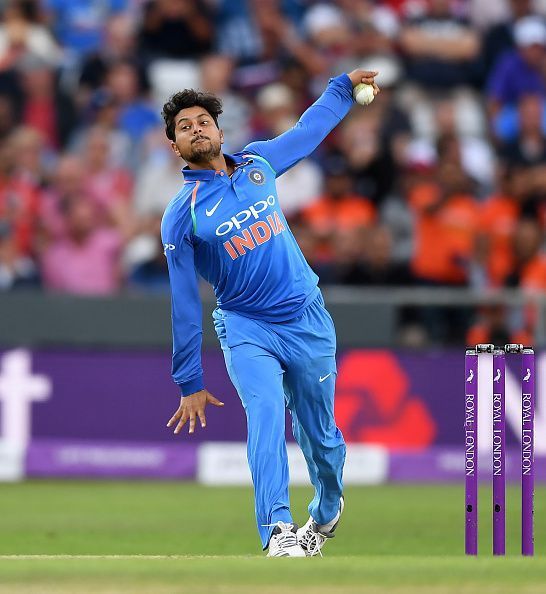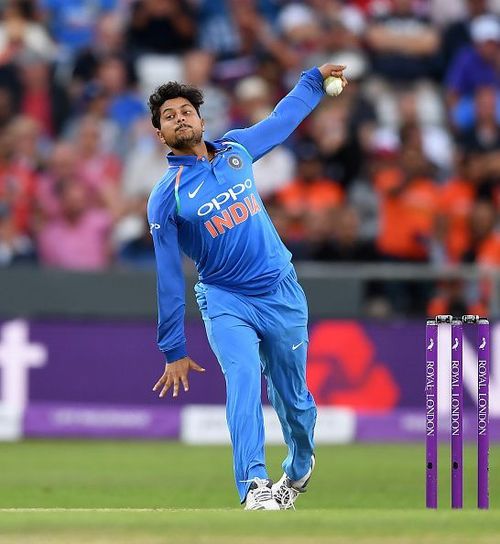
The reasons why India need to play around Kuldeep Yadav

The first thing that comes to mind when you look at a rather unorthodox bowler like Ajantha Mendis, Sunil Narine or even Kuldeep Yadav, is mystery and intrigue. But Kuldeep or Team India for that matter cannot depend on just the mystery factor - as it has worked against bowlers once the mystery has been unraveled.
Kuldeep, first of all, is not that much of a mystery bowler as Mendis or Narine. His bowling action is quite orthodox and straight-forward - similar to that of Shane Warne in his initial days. One thing that clearly separates Kuldeep from other wrist-spinners is his left-arm. But if you've watched cricket in the 2000's, you surely haven't missed out on seeing Australia's two-time World Cup champion chinaman bowler Brad Hogg - have you?
The third thing that comes into the equation is his release of the ball, which is quite different from other wrist spinners. His stock ball (the leg-spinner to the left-hander) and googly are not easy to differentiate from his hands - which poses many problems. Plus with the amount of flight and rotations he is able to extract, both his variations spin square on even the flattest of tracks - which makes him a lethal force.
But most batsmen who have applied themselves have shown that his bowling is playable. Even the Hong Kong batsmen, who faced him for the first time yesterday, were playing him easily once they were set. And that is where Kuldeep's temperament is tested. Since yesterday was not the first time Kuldeep's depth was tested, he delivered. He stuck to his line and length, slowed his bowling speed further on a slow wicket and forced the batsmen to make mistakes - and they did.
Kuldeep Yadav, who made his senior international debut for India just 18 months ago, has acquired considerable experience in this period. Since his debut, he has toured West Indies, Sri Lanka, South Africa, England, and now the UAE. But he has also played Australia and New Zealand at home. Playing in different conditions and against different opponents has certainly challenged Kuldeep, but he has still managed to become joint-fourth fastest bowler to reach 50 ODI wickets.
Kuldeep, as well as his spin twin Yuzvendra Chahal possess a big heart like senior leg-spinner Amit Mishra and former great Anil Kumble. They will all not mind getting hit as long as they are creating chances for their team and filling the wickets column. The fact is that out of Kuldeep's 24 ODI's, India have won 17. This has got a lot to do with the presence (and consistency) of two wrist spinners in India's attack - Kuldeep Yadav and Yuzvendra Chahal.
While Kuldeep delivers on most days, India wins on most days when Kuldeep does deliver. And when other bowlers contribute, India's chances of winning are over 90%. Kuldeep took 21 wickets in the 7 limited-over internationals he played on the previous tour to England and Ireland, but the next best bowler on tour was Chahal with 9 wickets from 8 matches.
While Umesh Yadav managed some wickets in the death overs, Hardik Pandya could deliver only one brilliant spell of four wickets in the last T20I against England. India still managed to win both the T20I tournaments (against England and Ireland), but lost the three-match ODI series 1-2 since only Virat Kohli and Rohit Sharma delivered in that series with either bat or ball.
In yesterday's match however, while Kuldeep did his job of taking wickets and delivering a tight spell in a tense defense for his team, contributions from most batsmen and bowlers did the trick for India. Yes, a couple each of India's bowlers and batsmen did not fire. But since seven other players including Kuldeep contributed, India won the match without taking it to the last over.
While Kuldeep and Chahal have had to shoulder the bowling responsibility, within less than a year of finding a regular spot in the team, they have not disappointed the faith one bit. This is similar to India's batting, where Virat Kohli has taken the onus on most days, followed by Rohit Sharma and Shikhar Dhawan.
Everyone who follows Indian cricket by now knows that players like Kohli and Kuldeep will contribute substantially on any given day. But if each individual in India's playing eleven starts to take that onus and years for that reputation, there would be less factors to question India's formidability.
Kuldeep's boundary-less spell of 6 for 25 restricted England for 267 in an ODI on the same pitch where they scored 481 against defending World Cup champions Australia less than a month prior. But don't make the mistake of keeping Kuldeep Yadav, or even Virat Kohli or Shane Warne at a pedestal above the team. Greats like Shane Warne, Glenn McGrath, Matthew Hayden and even Sachin Tendulkar could only win a World Cup when other members in their team contributed, despite the fact that they topped their country's charts.
For example, Shane Warne, with 20 wickets in the tournament, won man-of-the-match awards with four-wicket hauls in both the semi-final as well as the final of the 1999 World Cup in England. But his team would not end up on the winning side, without contributions from Michael Bevan, Damien Fleming, Glenn McGrath, Steve Waugh and Adam Gilchrist. Kuldeep, who would be expected to play a similar for India in next year's World Cup - also in England - would also expect the team to compliment his efforts in a similar manner.
As far as Kuldeep himself is concerned, he is doing his bit by taking the pressure of international cricket in his stride and fulfilling the job he has been signed up for. For the amount of spin he can extract, Kuldeep is definitely more talented than India's leg-spin legend with 956 international wickets Anil Kumble - who introduced the former to the team. But for all the talent in the world, Kuldeep knows that just like his mentors Warne and Kumble, only hard work will keep him going, and he is learning that with every passing day.